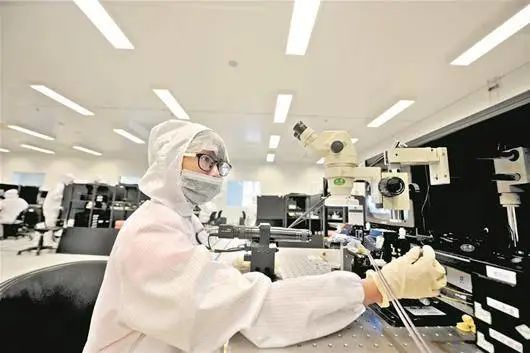Behind the decline of IPG's performance: the rise of China's fiber laser source industry
A few days ago, the global leader in fiber laser sources, IPG Photonics of the United States, announced its fourth quarter and full-year financial results as of December 31, 2021. The report shows that the company will achieve revenue of US$1.461 billion in 2021, a year-on-year increase of 22%; net profit will be US$278 million, a year-on-year increase of 74%.
This looks like a very decent financial report. However, in the Chinese market, IPG has experienced a significant decline, with a decline of 20% in the fourth quarter. To this end, IPG consoled itself by saying, "Sales outside of China accounted for 69% of our mid-income revenue, a level we haven't seen in years, indicating that we're making progress in improving the balance of our business." Looking ahead to the first quarter of fiscal 2022 , the company said it was pursuing profitable growth opportunities for IPG products in electric vehicle applications, renewable energy, handheld welding, the medical market and ultrafast lasers to "break out of China's highly competitive high-power cutting market."
IPG has been losing ground in the Chinese market, and it is difficult to fight against the fierce competition. It is obviously a competitor from China.

Is IPG going to "get rid of its main business" in the Chinese market?
Fiber laser sources are an important class of industrial equipment with the advantages of high power limit, low maintenance cost, simple structure, flexibility, and windability. They are widely used in display and panel glass cutting, 5G LCP cutting, OLED flexible display material cutting and other fields. It is one of the indispensable equipment for industrial manufacturing. Data show that fiber laser sources are the mainstream technology route in the current industrial field, accounting for more than 50%, far ahead of semiconductor, solid, and gas lasers. According to the "2021 China Laser Industry Development Report" by the Chinese Academy of Sciences, China's fiber laser source revenue in 2018-2020 increased from 7.743 billion yuan to 9.42 billion yuan.
In the early years, the Chinese fiber laser source market was almost monopolized by European and American companies, especially the high-power fiber laser market with high technology density. After 2000, China's fiber laser industry began to grow gradually. One of the representative companies is Wuhan Raycus Fiber Laser, which was established in 2007. The founder returned from overseas. With profound technical knowledge and unparalleled application environment in the domestic market, Raycus has grown fast. From low power to medium power, gradually eroding the share of foreign giants such as IPG. Today, in the technology-intensive high-power fiber laser market, IPG is also starting to lose ground.
According to Ta Jian's research, in the IPG fiber laser source business, high-power continuous lasers account for 66%; medium and low-power pulsed lasers account for 16%, and pulsed lasers account for 22%. IPG's high-margin high-power fiber laser business dominates, but in the Chinese market, the company has to face fierce competition, which shows the heavy pressure from Chinese competitors.
In fact, in China's low and medium power fiber laser market, IPG is "escaping". In order to maintain higher profit margins, IPG is obviously retreating faster for markets with low profit margins.

While IPG seeks comfort from overseas markets, local Chinese competitors such as Raycus, Shenzhen JPT, and Maxphotonics (unlisted) have risen rapidly. In the past two years, the spread of the new crown epidemic in 2020 has led to a decline in the demand of laser equipment manufacturers, and the performance of three fiber laser manufacturers such as IPG, Raycus and Shenzhen JPT have all experienced negative growth. The financial report shows that benefiting from China taking the lead in resuming work and production, the two local manufacturers of Raycus and Shenzhen JPT took the lead in recovering growth in the second half of 2020. In 2021, the Chinese market once again launched fierce competition.
Raycus Laser recently released the 2021 performance forecast, showing that the company will achieve revenue of 3.3 billion to 3.5 billion yuan in 2021, a year-on-year increase of 42.45% to 51.08%; net profit of 460 million to 490 million yuan, a year-on-year increase of 55.36% to 65.49% %. The company said that in 2021, it will successfully launch a variety of new products for high-end applications such as ring spot welding lasers and compound cleaning lasers to the market, resulting in a steady increase in laser sales and operating income, and the company’s net profit has maintained growth.
According to the 2021 performance forecast of Shenzhen JPT, it will achieve revenue of 1.18 billion to 1.21 billion yuan, a year-on-year increase of 38.23% to 41.25%; net profit of 90 million to 105 million yuan, a year-on-year increase of 103.17% to 137.03%. The company said that the proportion of new product sales continued to expand, and the average price of products was increased, which promoted the improvement of the company's business performance and overall profitability.
It can be seen that the performance of Chinese fiber laser companies is in sharp contrast with IPG's performance in the Chinese market. Objectively speaking, the products of Raycus and Shenzhen JPT are mostly low and medium-power products with relatively low gross profit margins. IPG is still in the leading position in the high-power field, and overseas fiber laser manufacturers such as trumpf are also strong.However, the ability to force IPG's high-power products to retreat in the Chinese market shows that the overall competitiveness has rapidly improved.